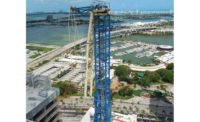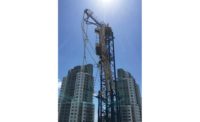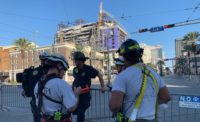Two cranes in the Miami area and a third in Fort Lauderdale suffered partial collapses on Sunday, Sept. 10, during the high winds of Hurricane Irma. No injuries were reported and damage to other structures was minimal, according to local officials.
The Miami cranes came down at a time when there are approximately 24 tower cranes working in the city. On learning of the collapses, city officials contacted the general contractors and "we sought the best way to secure to tower crane arms from collapsing further and get structural engineering reports on the affected buildings,” said Maurice Pons, deputy director of the city’s buildings department, in a press conference on Sept. 11. “It’s way too early to determine exactly what happened.”
The three partial-crane collapses raised issues related to a long-simmering dispute over crane standards in Miami-Dade County, an area which has one of the country's densest concentrations of high-rise building construction on coastal properties exposed to hurricane force winds.
"I was very disappointed that the city of Miami said cranes can withstand 145 miles-per-hour."
–Crane inspection specialist Greg Teslia
One of the fallen cranes was at the GranParaiso high-rise condominium development, which has several other tower cranes on site. Lead contractor Plaza Construction issued a statement, saying that “the crane engineers and crane supplier took measures to secure the crane. The crane's boom was nevertheless damaged due to high winds.”
The other damaged crane in Miami, was located at 400 Biscayne Boulevard, the site of a residential tower that will have 464 rental apartments when complete. John Moriarty & Associates of Florida is the general contractor on the project, city officials said.
The Fort Lauderdale crane was working on the Auberge Beach Residences & Spa, located at 2200 N. Ocean Blvd. The general contractor on the project is Moss Construction. A spokeswoman for Moss told the Associated Press that the crane came down around 5 p.m. Sunday. A team from Moss was on the scene Monday, Sept. 11.
Securing a crane for hurricane strength winds is a complex job, but crews and engineers need to work to the specifications of the particular make and model of the crane, according to Mike Parnell, technical director at the Industrial Training International, which provides training for certification in crane operation and rigging. “It varies by manufacturer and the model. Some say you should secure the crane in all cases, others recommend you cut the swing brake and let it weathervane.”
Rigging and blocks are secured or removed as needed, and the crane is only allowed to "weathervane" if it has 360° of access normally, said Parnell.
Allowing cranes to spin freely on their turntables and weathervane is a common approach to protecting cranes in high winds, according to Parnell. “The intention is to put the jib in the least broadside perspective of the wind,” he says. “Winds can come in from all sides in a hurricane, so generally it’s considered the bast way to try and have a crane survive.” Still, he adds, no manufacturer offers recommendations for guaranteed survival of hurricane-force winds. “There’s no crane out there today that comes with a full explanation of what happens in those sort of conditions,” he says.
What Wind Speeds Can a Crane Withstand?
According to ITI’s Parnell, some cranes models can withstand only 70 mph to 80 mph winds when fixed, but may survive winds up to 140 mph when allowed to weathervane. Officially, tower cranes are supposed to meet the European standard of withstanding 93 mph winds. Reports show that at least one of the cranes in Miami had been allowed to weathervane.
A statement issued by the city of Miami on Sept. 5 said the city’s tower cranes were rated to withstand winds up to 145 mph. But crane inspection specialist Greg Teslia takes issue with the city’s statement.
“I was very disappointed that the city of Miami said cranes can withstand 145 mph,” he told ENR. “Maybe the base foundation can handle that, but the full height and the tie-ins? They’re probably not designed to handle that.” And even allowed to weathervane, cranes can have problems, says Teslia. “If cranes are rotating violently and fast in a hurricane, who's to say the bearings in the turntable didn’t seize? A lot can happen.”
Teslia is president of Crane Safety & Inspections Inc, a third-party firm that inspects cranes and manlifts on sites across the US. CS&I has an office in South Florida, and a share of the tower cranes currently erected in Miami were inspected by the firm when they were going up and at 90-day intervals afterwards.
“The biggest problem some of these projects have is keeping to the [crane’s] engineering plan,” says Teslia, “The plan may say to jump down so many tower sections above a tie-in if there’s an oncoming storm, but it’s a problem if there’s not enough experienced crews around to jump down those tower sections in time.”
Long Fight Over Crane Safety Standard
The collapse of the two cranes in Miami also brings up a near-decade-old legislative fight. There is still debate over a 2008 crane-safety ordinance issued by Miami-Dade County which was overturned by a district court. Among other regulations, the ordinance required for cranes to meet the ASTM B30.3 standards for tower crane safety, in addition to following federal OSHA regulations and manufacturers' recommendations.
A successful legal challenge by building and contracting groups argued that the the ordinance violated the OSH act, which sets federal safety standards above local ordinances. A district court found that the federal government set standards for wind loads on cranes.
“I was there in 2008,” recalls Teslia, who served on the county committee as an advisor on codes and standards. “Miami-Dade County wanted to do the right thing, but they were defeated.”
Federal standards for wind-load limits are not as stringent as those the proposed county ordinance, but after these recent incidents there may be signs of political will to reexamine the problem. “ This has been a big source of anxiety for people downtown,” said Ken Russell, Miami city commissioner for District 2, which includes the sites of the crane collapses. “We were fortunate [the cranes] came down on the buildings that were being constructed and did not strike any of the surrounding buildings, and no one was hurt. But for sure we as a city are going to look into legislation, regulations and practices in the future about how these cranes are handled during a storm."







Post a comment to this article
Report Abusive Comment